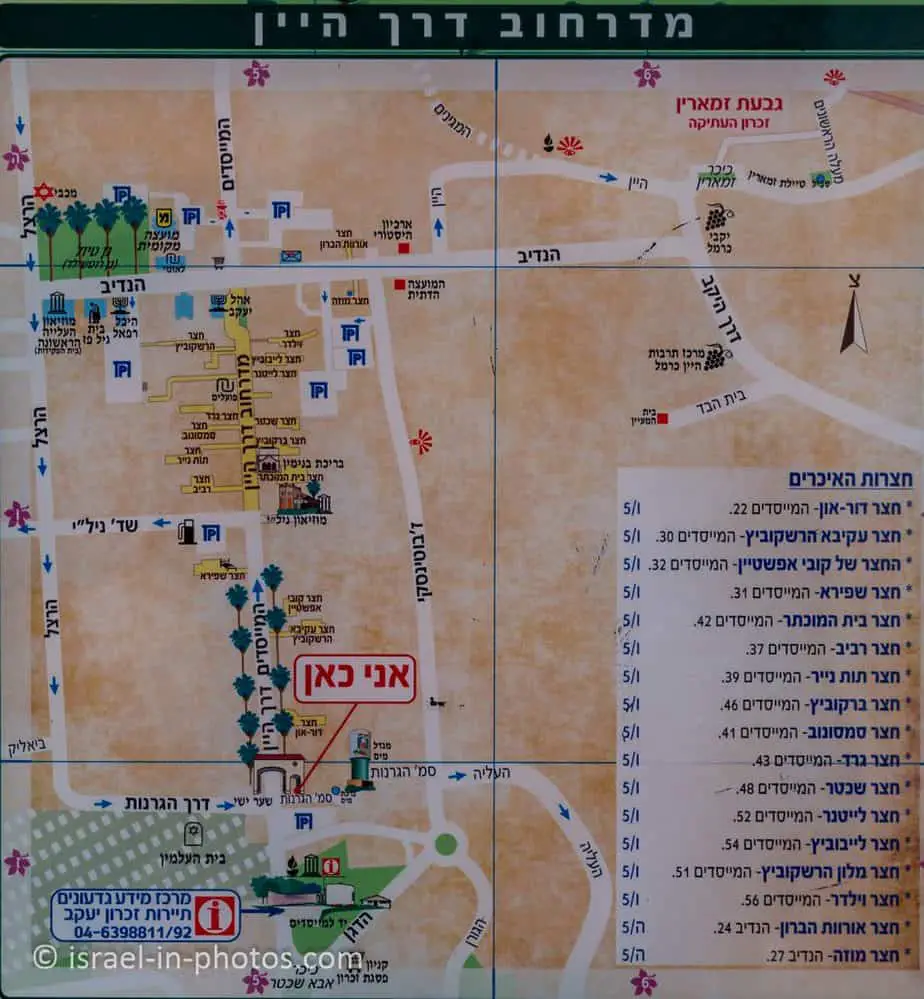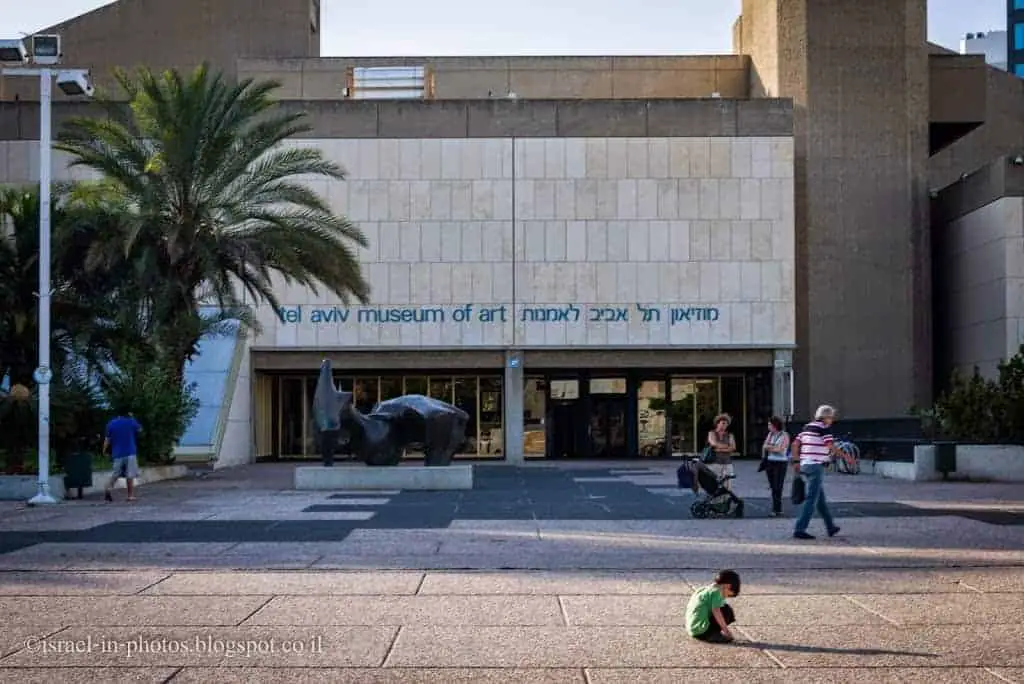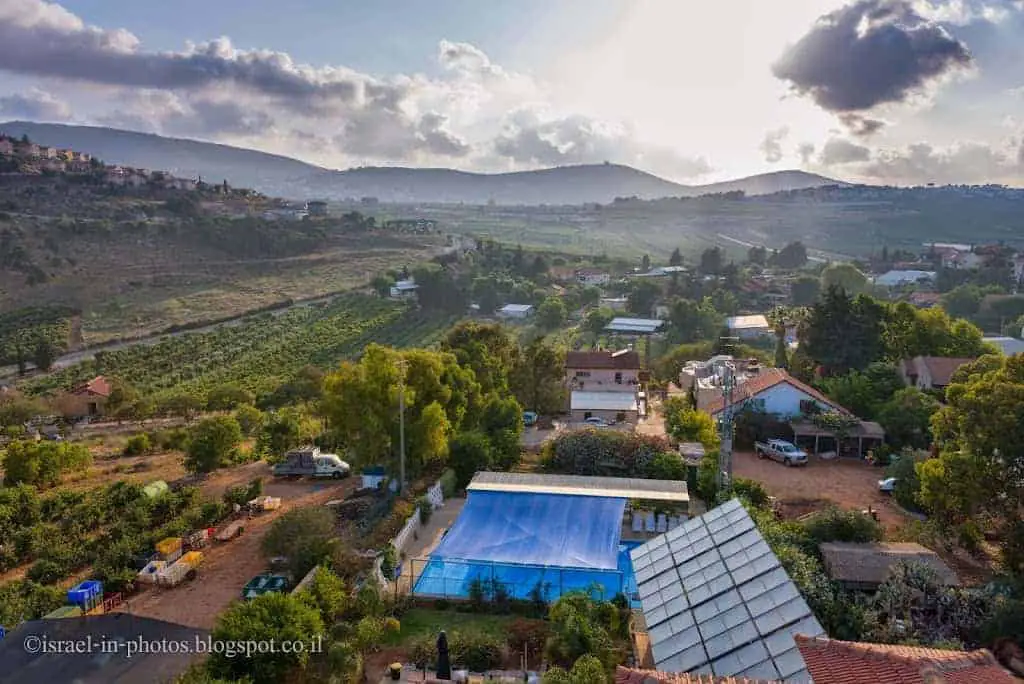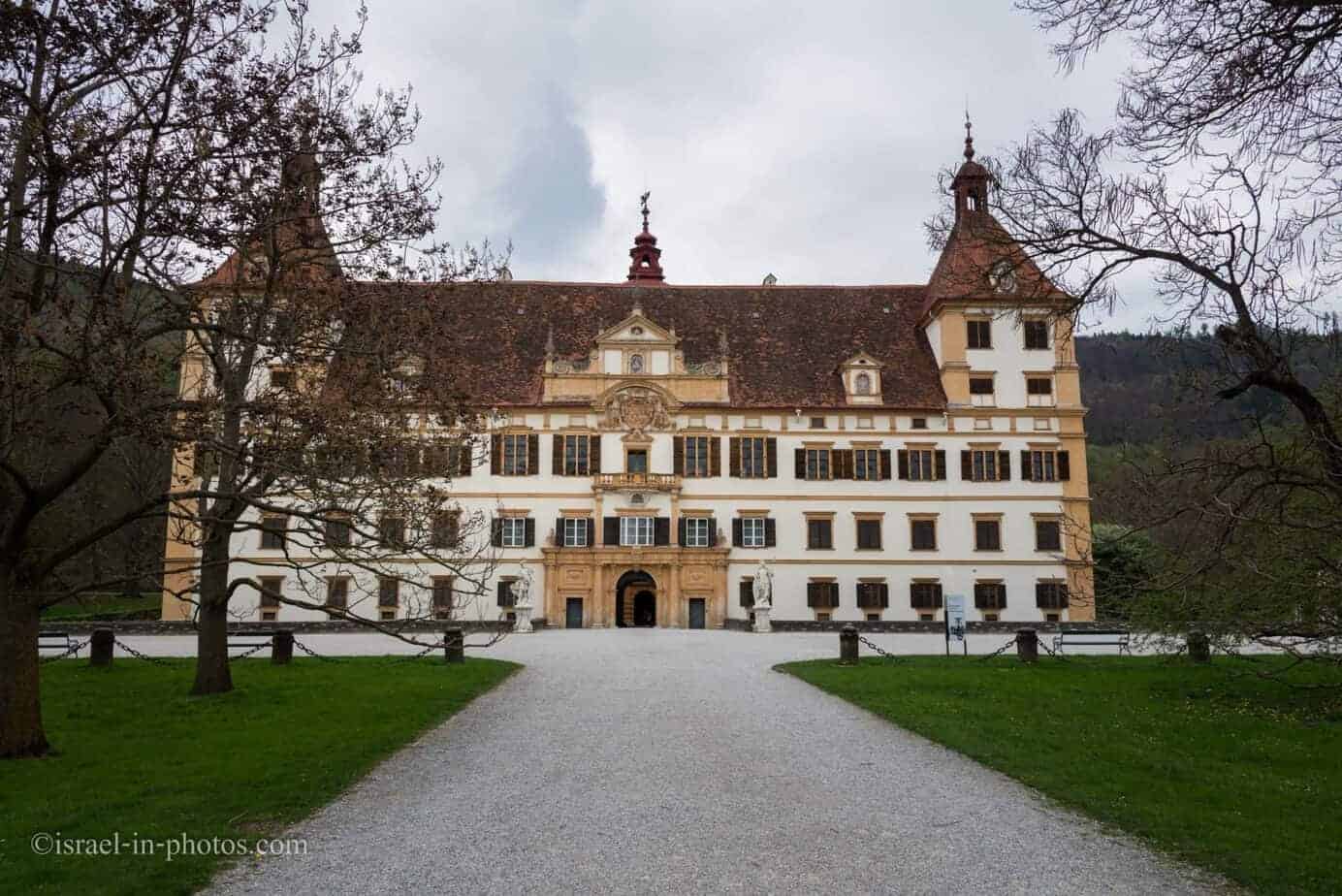Zichron Yaakov – Visitors Guide (Map, Attractions, and More)
Zichron Yaakov is a town on Carmel Mountain in Haifa District. It was founded in 1882 with the help of Baron Edmond James de Rothschild.
Table of Contents
- 1 Map
- 2 Directions
- 3 Parking
- 4 What does Zichron Yaakov mean?
- 5 HaMeyasdim Street
- 6 Wineries
- 7 Pedestrian Mall
- 8 Beit Aaronsohn – Nili Museum
- 9 Beit Hamuchtar
- 10 The Benjamin Pool
- 11 Tut-Neyar Paper Mill
- 12 Farmers’ Courtyards
- 13 Restrooms
- 14 Ohel Yaakov Synagogue
- 15 The First Aliyah Museum
- 16 History
- 17 Nearby Attractions
- 18 Summary
Map
Zichron Yaakov is located on the Carmel mountain range about 35 km south of Haifa and 15 km from Caesarea.
Directions for drivers: Link to Waze and Link to Google Maps
Directions for public transport: Link to Moovit
Interactive map of the area:
And here is a photo of a sign on HaMeyasdim Street.
Note: you can click on the map to enlarge it.
But most people are not interested in a map of the whole city, but rather a specific area: HaMeyasdim Street and the pedestrian mall. Thus here is the map of the historical area:
Directions
On our latest visit, we parked near Ha-Meyasdim Street 8. Hence, you can enter that address into Waze.
If you use public transport, you can take different buses. Here is already a preset link to Moovit. Just enter your starting point, and you will get the updated directions.
Parking
There are many parking lots, and you can see them on the maps above. During our most recent visit, we parked at the free parking lot by Ha-Meyasdim Street 8.

What does Zichron Yaakov mean?
Zichron Yaakov means in memory of Yaakov. James Mayer de Rothschild (James derived from Jacob, Yaakov) was Baron Edmond James de Rothschild’s father, and the city is named in his honor.
HaMeyasdim Street
We will start our tour near the water tower and Zamarin Hotel at Ha-Meyasdim Street 16. There you can find the Yishai Shibovski gate. Also, you can find the signs with maps at the top of the post.
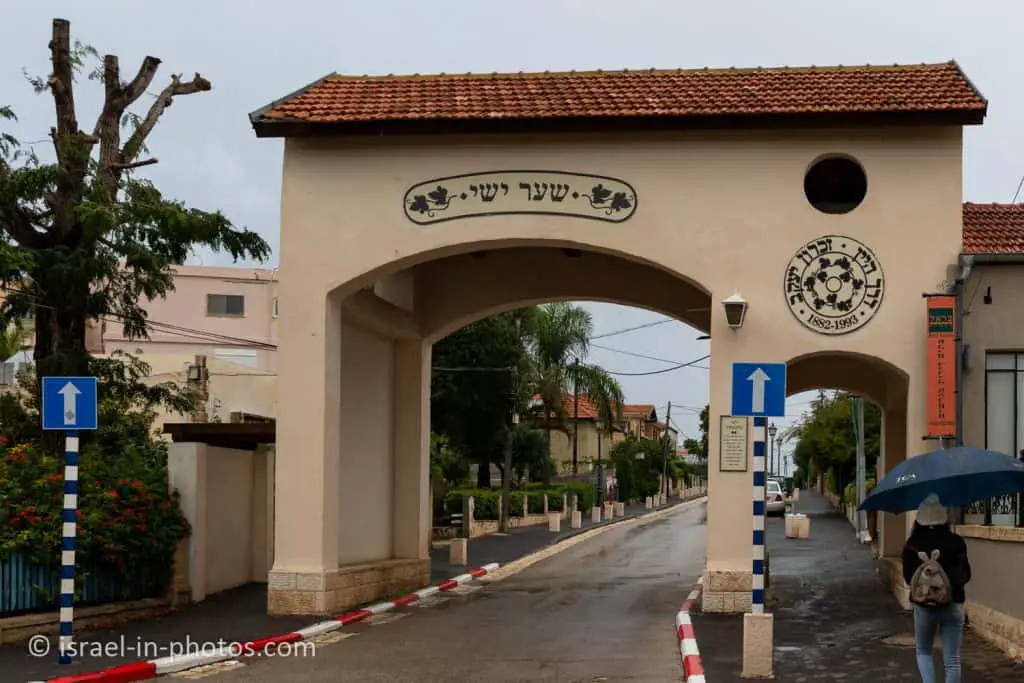
On this street, you can find the houses of the founders. Here is, for example, Beit Bonstein.

As you can see, there are explanation signs near the houses.
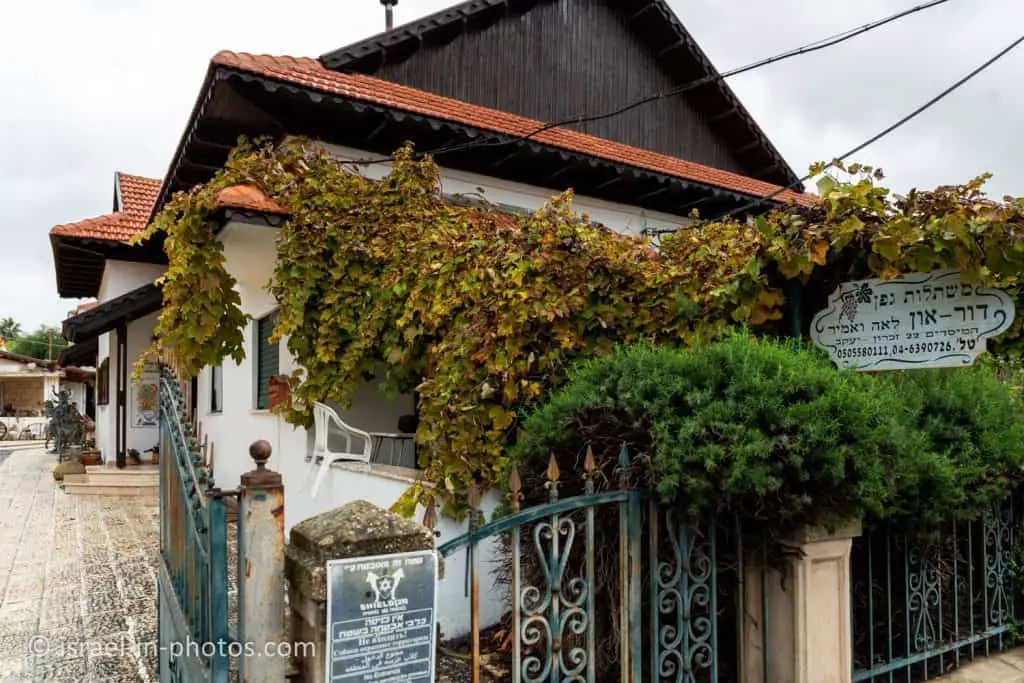
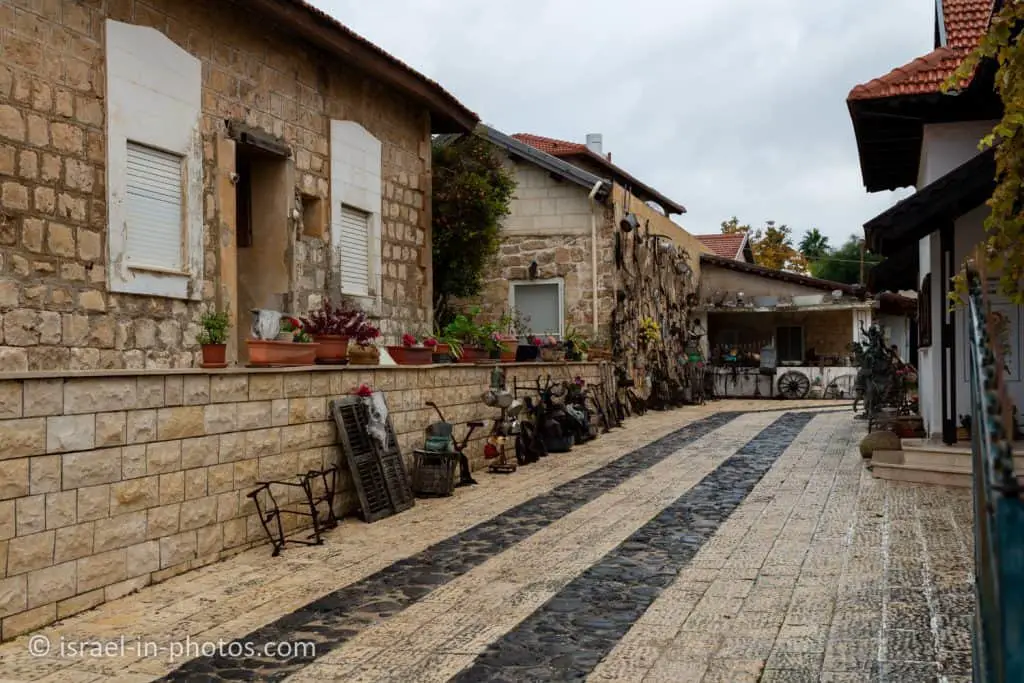
Chaim Bar Schwartz was one of the founding fathers of Zichron Yaakov. He was a deeply religious man who fulfilled the Biblical precept of making the foot pilgrimage to the Western Wall in Jerusalem. Hence, he was called the Foot Pilgrim, and this was his house:
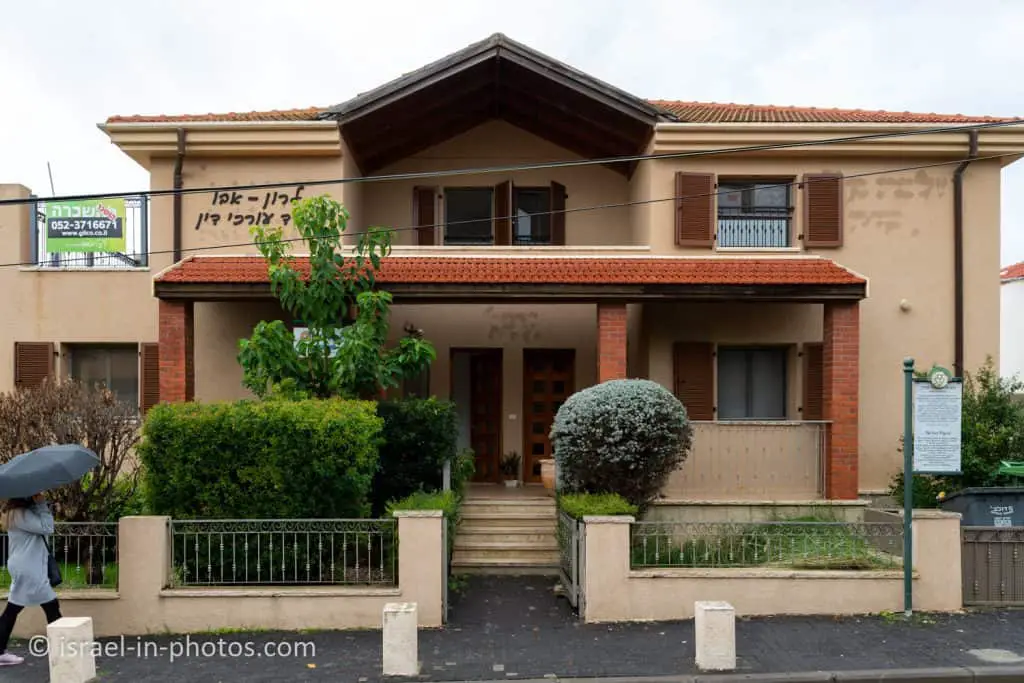

Our latest visit to Zichron Yaakov was in December 2020, and it was rainy. And since it is a short urban walk, you can visit Zichron Yaakov all year round. But try to avoid rainy and sweltering days.
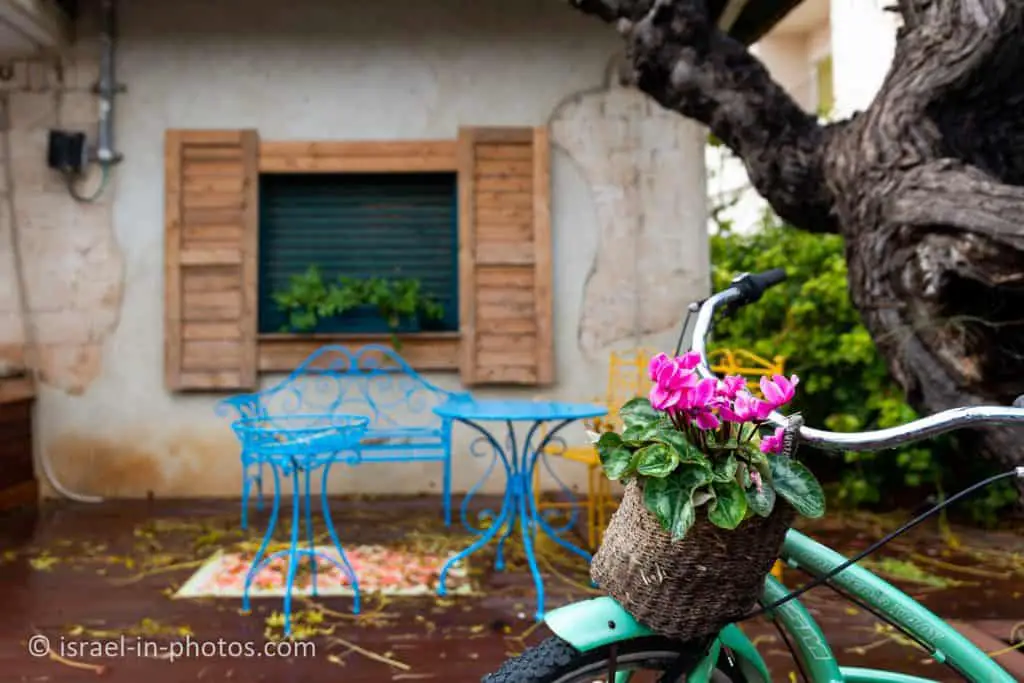
Wineries
After a short walk along HaMeyasdim Street, we reached Smadar Hotel and Winery. Thus let’s talk about wineries.

Under the supervision of Edmond de Rothschild’s administrators, farm colonies and vineyards were established. Two major wineries were opened – one in Rishon LeTsiyon and another in Zichron Yaakov.
In 1885 Carmel-Mizrahi winery was opened in Zichron Yaakov. It is still active, and you can purchase products or join a tour at The Wine & Culture Center of the Carmel Winery. For additional info, see the official site.
Carmel Winery is not the only winery in Zichron Yaakov. There are also Tishbi Winery, Somek Winery, Poizner Winery, and Smadar Winery.
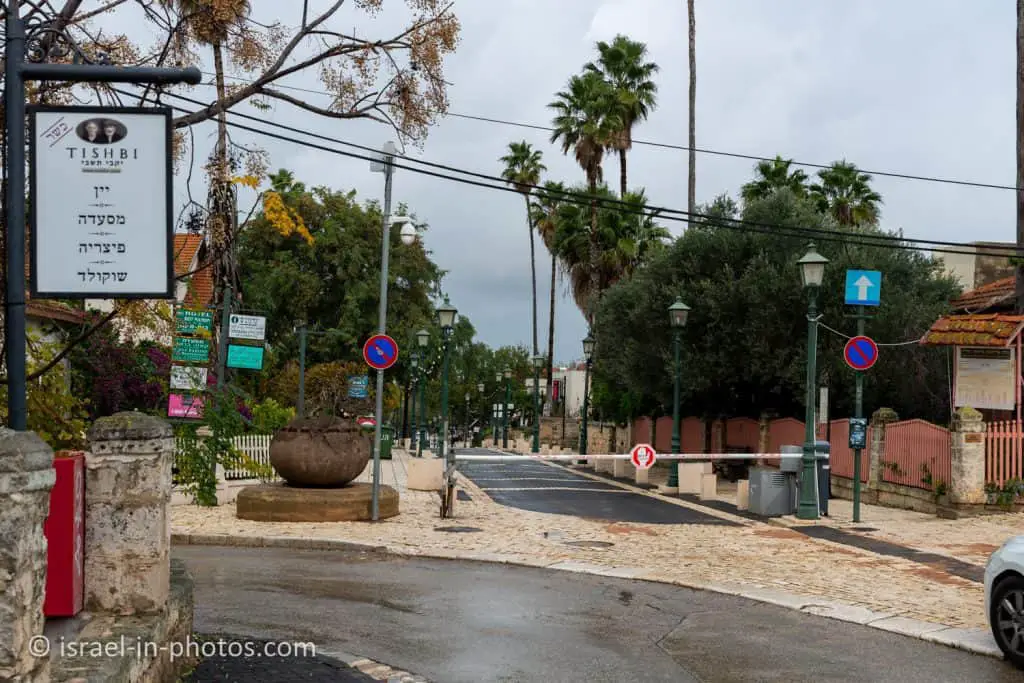
Pedestrian Mall
As you can see in the photo above, at some point, HaMeyasdim Street (also called Wine Route) is closed to vehicles. This section is also called the pedestrian mall.
You can find restaurants, stores, historical sites, museums, and more at the pedestrian mall.
The Wine Route is Zichron Yaakov’s famous pedestrian street Ha-Meyasdim St. In this century-old street that has been preserved, there are many charming spots, boutique stores, artist galleries, coffee shops, and restaurants. The houses that face the street were once home to the founding families, the first settlers. Each of the quaint courtyards behind the houses was once a farmyard with chickens running about. The farmers’ courtyards, which branch off the main street, offer many pleasant surprises.
On the right side of the photo above, you can see the billboard of Beit Aaronsohn – Nili Museum.
Beit Aaronsohn – Nili Museum
Nili stands for “Netzach Israel Lo Yishaker” – The Eternity of Israel will not deceive (Samuel I, 15:29). This phrase expresses the eternity of the people of Israel and, in some contexts, the eternity of the tradition of Israel.
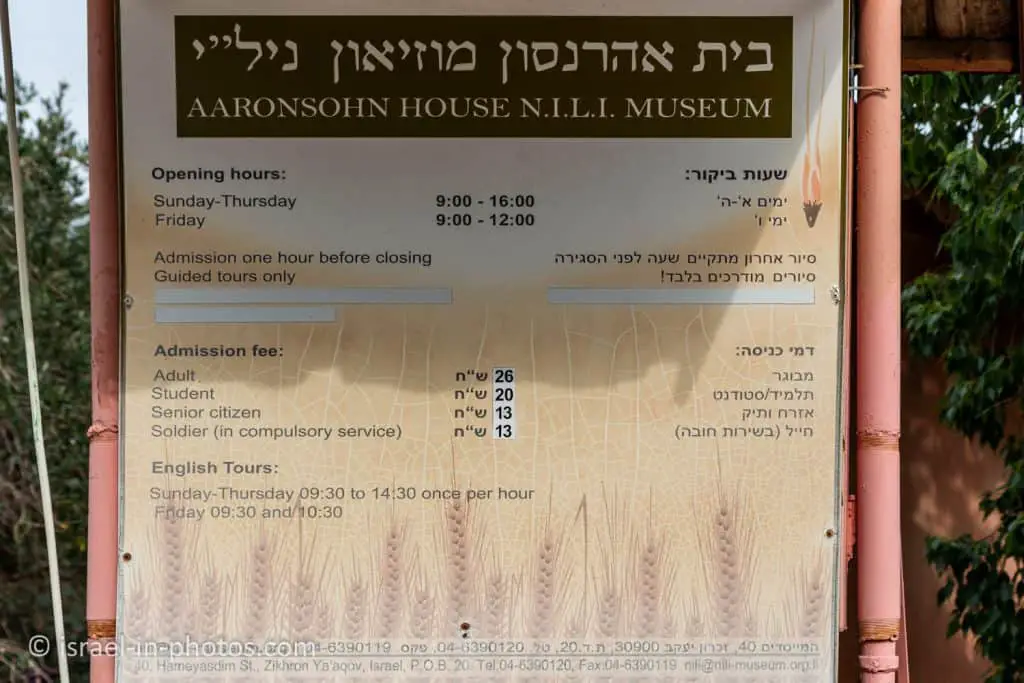
The underground Nili network was established in 1915 and operated in Eretz Israel during WWI. Its objectives were:
To assist the British effort to conquer Eretz Israel by gathering information.
To support the Jewish Yishuv in Eretz Israel in a time of famine and disease.
To draw world attention to what was happening in Eretz Israel.
To fulfill the dream of establishing a Jewish State in Eretz Israel.
Nili was founded and led by agronomist Aaron Aaronsohn from Zikhron Ya’akov, joined by his sister Sarah and brother Alexander, as well as Avshalom Feinberg from Hadera, brothers Na’aman and Eitan Belkind from Rishon LeZion, Yosef Lishansky from Metula and dozens of others.
The organization operated from Athlit, where Aaron’s Agricultural Experiment Station was located. British forces regularly sailed between Egypt and Athlit – the British warship Managam frequently came ashore at Athlit to collect the information gathered by Nili members. Information was also passed on via homing pigeons.
In the spring of 1917, rumors about the espionage organization circulated the Yishuv. Several events led to the exposure of the organization in September 1917: a British coin was found in the market in Ramleh, a homing pigeon failed to complete its mission and landed in the governor’s yard in Caesarea, and Na’aman Belkind was arrested by Turkish authorities.
Following these events, the Turks began a campaign of threats and terror against the Jewish Yishuv to apprehend Nili members. Many were, in fact, caught and tortured. Sarah Aaronsohn committed suicide after undergoing severe torture. Na’aman Belkind and Yosef Lishansky were executed in Damascus.
The bravery and heroism of the men and women of Nili helped the British enter Eretz Israel and end the Ottoman rule.
Source: Beit Aaronsohn – Nili Museum

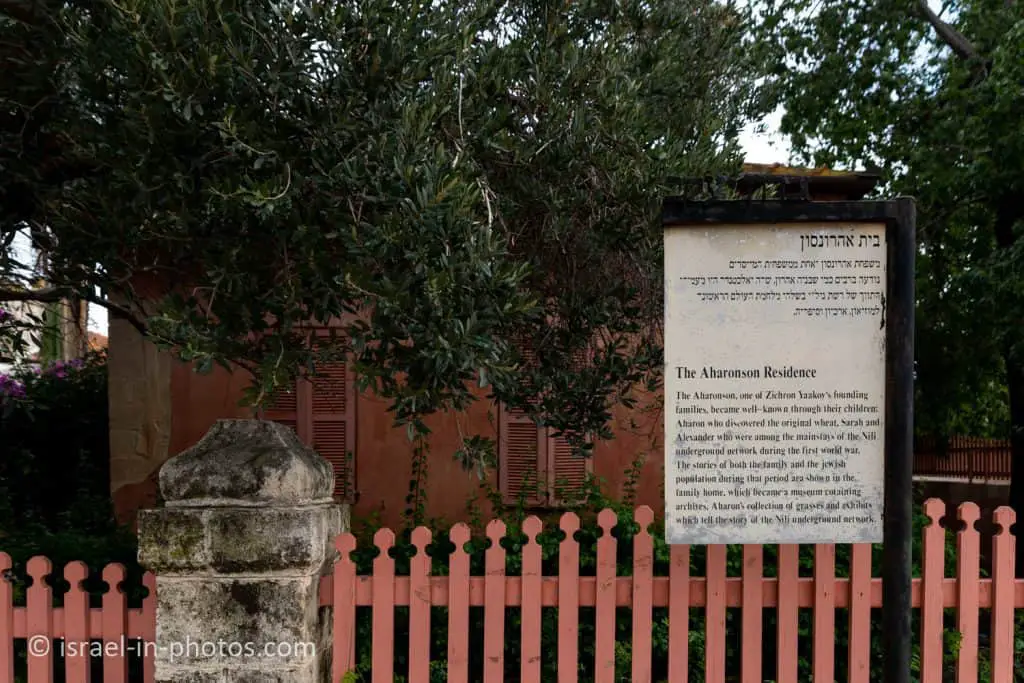
Since we visited Zichron Yaakov between lockdowns, the museum was closed. Thus we will continue walking on the pedestrian mall.

After a short walk, we reached Beit Hamuchtar.
Beit Hamuchtar
By the way, many street signs tell about former residents and events. Here is, for example, Pinchas Krystal. He was a photographer. And you can see his photos near Beit Hamuchtar.
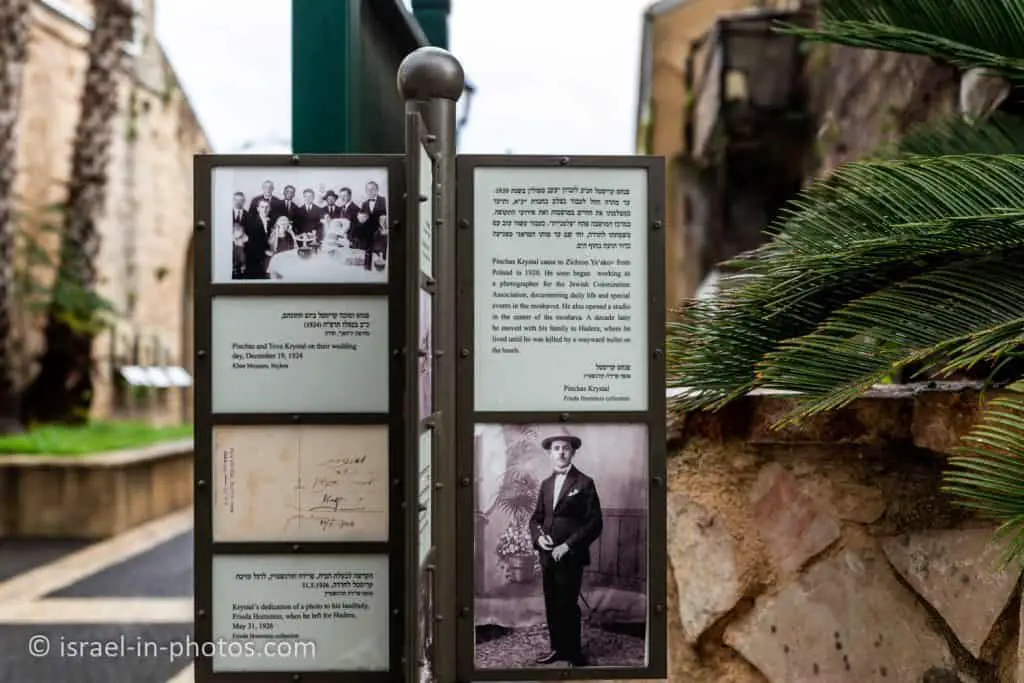
Beit Hamuchtar is a spectacular historic house in the heart of Zichron Yaakov’s pedestrian street, overlooking Mount Carmel. The building had undergone careful restoration and preservation.
It was built by Ezekiel Hornstein who immigrated with his family to the land of Israel in 1882 and was one of the founders of Zichron Yaakov. Being a key public figure, industry entrepreneur, polyglot, well versed in government law, and a man of vision, action, wisdom, and charisma, Ezekiel Hornstein was appointed Muchtar (head of the village) of the Moshava by the Ottoman government.
Due to his position, his home was erected in the highest most central spot of the Moshava. It included an aqueduct that led water to the Binyamin Pool reservoir – the first waterworks in the land of Israel.
During the conservation and restoration of the house, a historical tunnel was discovered. It was excavated underneath the house and connected the next-door Aaronson family home to an exit on the mountain slopes. A member of the NILI espionage network, Yosef Lishansk, found refuge in this tunnel.
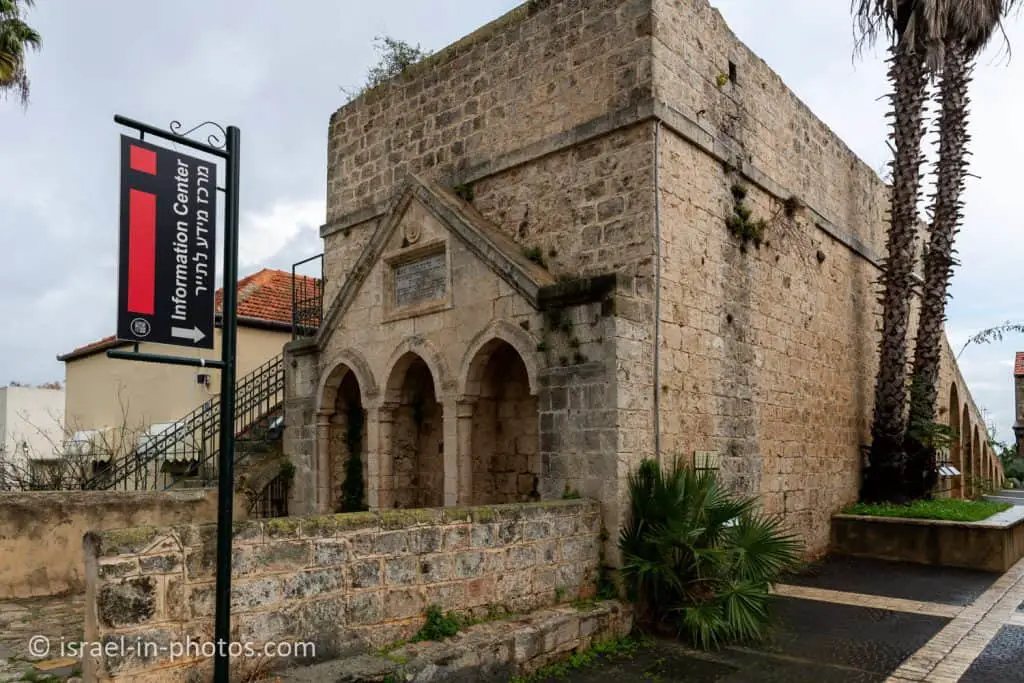
As you can see in the photo above, there is an information center. But it was closed due to Coronavirus.

Signs are telling about Ezekiel Hornstein and other residents.

And now, let’s return to the main street to the Benjamin Pool.
The Benjamin Pool
This water reservoir was built by the generous Baron Benjamin Edmond de Rothschild. It was the first of its kind in Israel and used a newly developed pump to bring water up to the village on the hilltop.
Built in 1891, it was considered wondrous for both its advanced engineering and architectural beauty. A 12-horsepower steam engine brought water up from the well below through underground pipes. The water was then piped, using gravity, to public drinking fountains and to the reflection pool in the center of the moshava farming village. The steam-powered pump marked the beginning of a new era in this country.

There are many signs on site. Thus you can enjoy your visit even if you came unprepared.
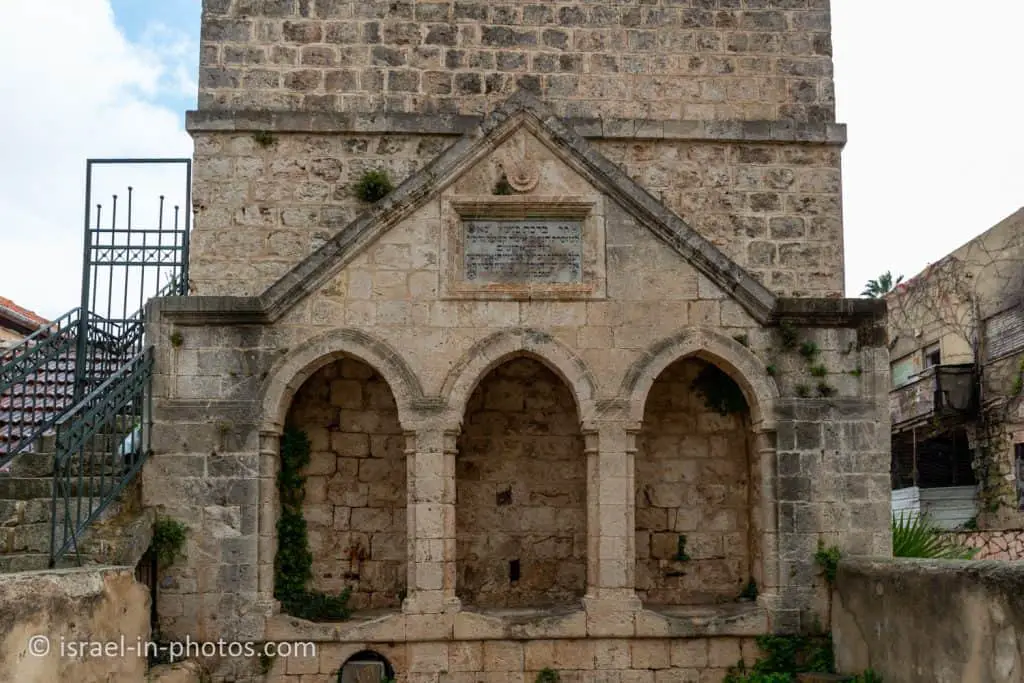
Tut-Neyar Paper Mill
On Hameyasdim Street 39, you can find one of the more popular places. It is called Tut-Neyar Paper Mill. This is a handmade paper gallery where you can join workshops or shop at their store.
Here is a short description from their site:
Tut-Neyar Papermill was established in 1986 by Timna and Izhar Neumann, in the old town of Zichron-Ya’akov, Israel, located on the Carmel Mountain, facing the Mediterranean Sea. We are dedicated to making quality handmade paper from the finest fibers. Our main raw material is the inner bark of the Paper Mulberry tree (Tut-Neyar in Hebrew or Kozo in Japanese), which we grow ourselves.
The mill is run as a small family enterprise by Timna and Shaked Neumann.
Making all the paper & paper products by hand assures high quality & unique finished products.

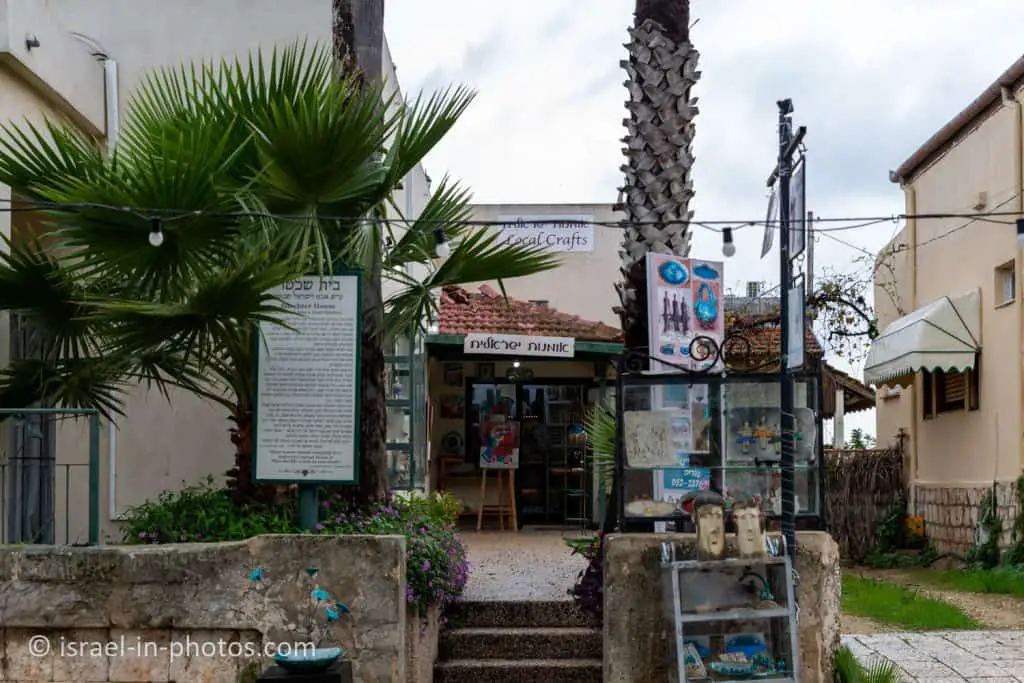

In the spirit of the times:
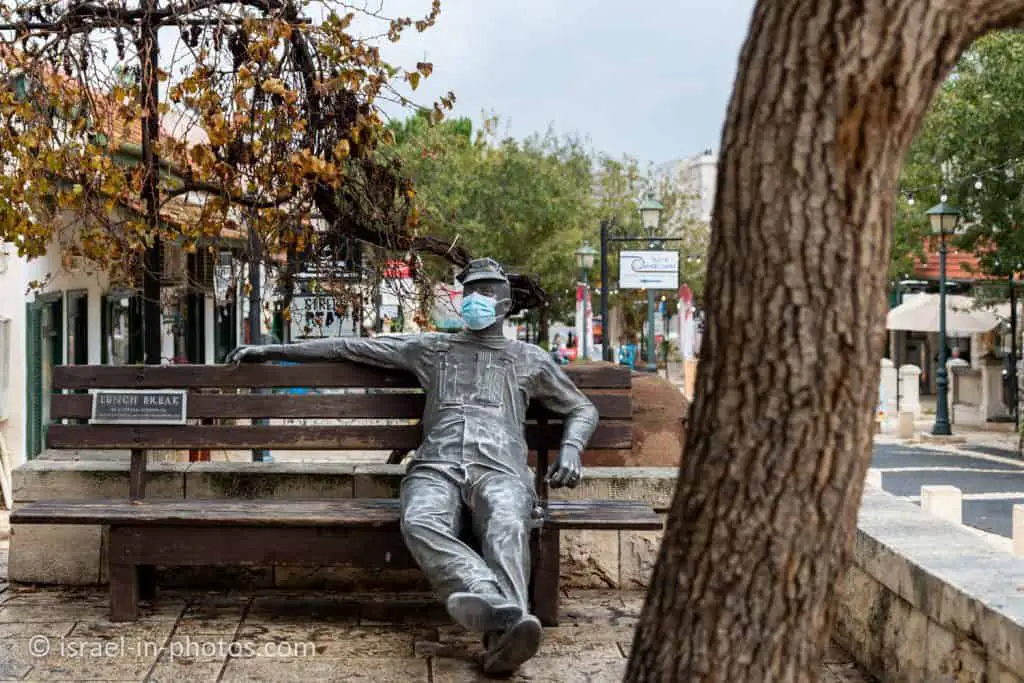
It was lunchtime, so we stopped by Nili Caffee. As it turns out, there is a local sandwich called Zichrona. It is a homemade bun stuffed with feta cheese, mozzarella, tomatoes, a fried egg, and herbs. Of course, I had to try it, and it was tasty.
If you love cheeses and looking for a place to eat near the city, see Schwartzman Dairy in Bat Shlomo.
Farmers’ Courtyards
On both sides of the pedestrian mall, you can find alleys leading to galleries, stores, and restaurants. Here is one such alley:
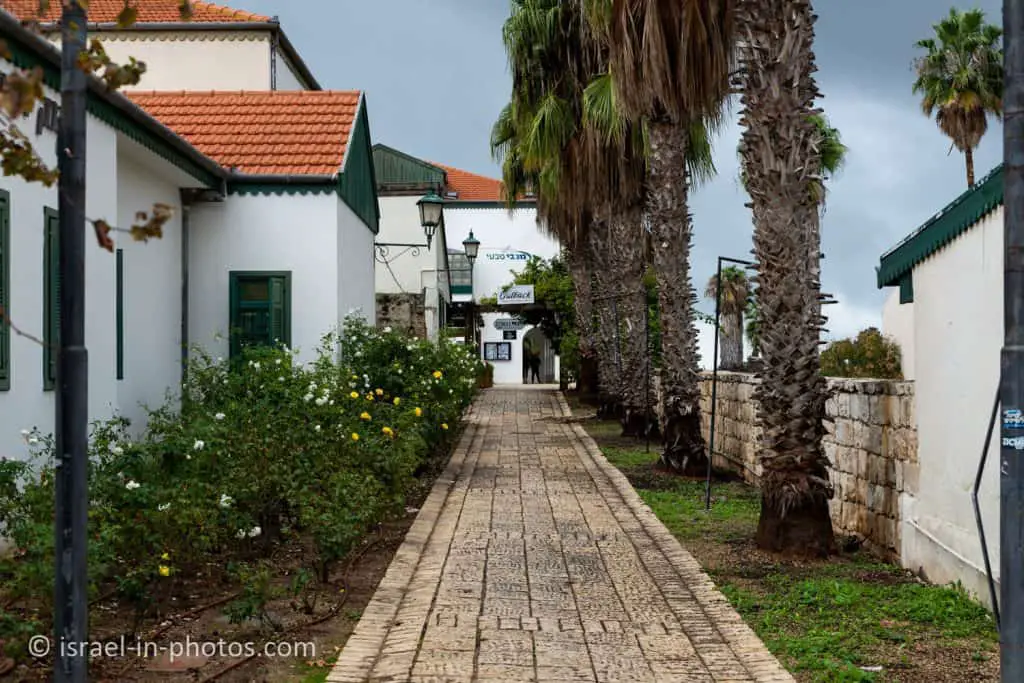
Don’t miss the big secret of Zichron Yaakov Courtyards that branch from the Wine Route pedestrian street. If you have visited here before, you will be happy to discover that behind the facades of the main street, there are hidden surprises that are updated and will surprise you again each time you visit.
The former farmyards behind each house – where the chickens and cows used to wander – have been turned into artist galleries, craft studios, and leisure sites. The smaller farmyards have been tastefully renovated and retain their rural roughness, reminding visitors of the past. How were the names of each courtyard decided? These are the names of the founding families, of course.
Shapira Courtyard – 31 Ha-Meyasdim St. – Winery and guest suites Horenstein Courtyard – 42 Ha-Meyasdim St. – The mayor’s house (beside Benjamin Pool) Raviv Courtyard – 37 Ha-Meyasdim St. – Culinary delight and art gallery Tut Neyar – 37 Ha-Meyasdim St. – Three generations of artisans make paper from the mulberry tree, using Japanese methods Samsonov Courtyard – 41 Ha-Meyasdim St. – Eatery in the family’s home and natural cosmetics in the courtyard Grad Courtyard – 43 Ha-Meyasdim St. – A row of small, charming shops, operated by women artists and artisans Berkovitz Courtyard – 46 Ha-Meyasdim St. – This courtyard still has chickens and the aroma of the past, veteran farmers and the farmer’s daughter, who produces artworks. Visits by advance arrangement. Yael Berkovitz, Tel: 052-4526519 Schechter Courtyard – 48 Ha-Meyasdim St. – A huge mulberry tree dominates the center of this courtyard. A drinking trough for horses sits in the corner, and there is an antique furniture shop Leitner Courtyard – 52 Ha-Meyasdim St. – A cluster of boutiques with the best of Israeli designer clothing Leibovitz Courtyard – 54 Ha-Meyasdim – A vibrant pub at night and a barbershop, seamstress and locksmith shop during the day. Authentic mixed-purpose Zichron Yaakov character Hershkovitz Hotel Courtyard – 51 Ha-Meyasdim St. – One of the beautiful renovation projects of recent years. This historic hotel building has hosted generations of VIP guests. There is also a coffee shop, fashion stores, medical offices, and an office for Rav Kav, the new public transportation payment system in Israel Wilder Courtyard – 56 Ha-Meyasdim St. – One side houses boutiques, and the other is the offices of the town planning committee (in case you decide to stay here and build a house). The entire courtyard is decorated with historical photos and pictures of the family patriarchs The Baron’s Stables Courtyard – 24 Ha-Nadiv St. – The baron’s horses and carriages used to leave from here, on visits to Shfeya and Rosh Pina. The high stone arches and the romantic courtyard warmly welcome visitors for a good meal or comfortable lodging in a private guest suite. Muza Courtyard – 27 Ha-Nadiv St. – The atmosphere of the narrow lanes continues here, where you can also find lovely boutiques, Italian food, and water gurgling in a stone fountain.

And here are several photos from Wilder Courtyard:

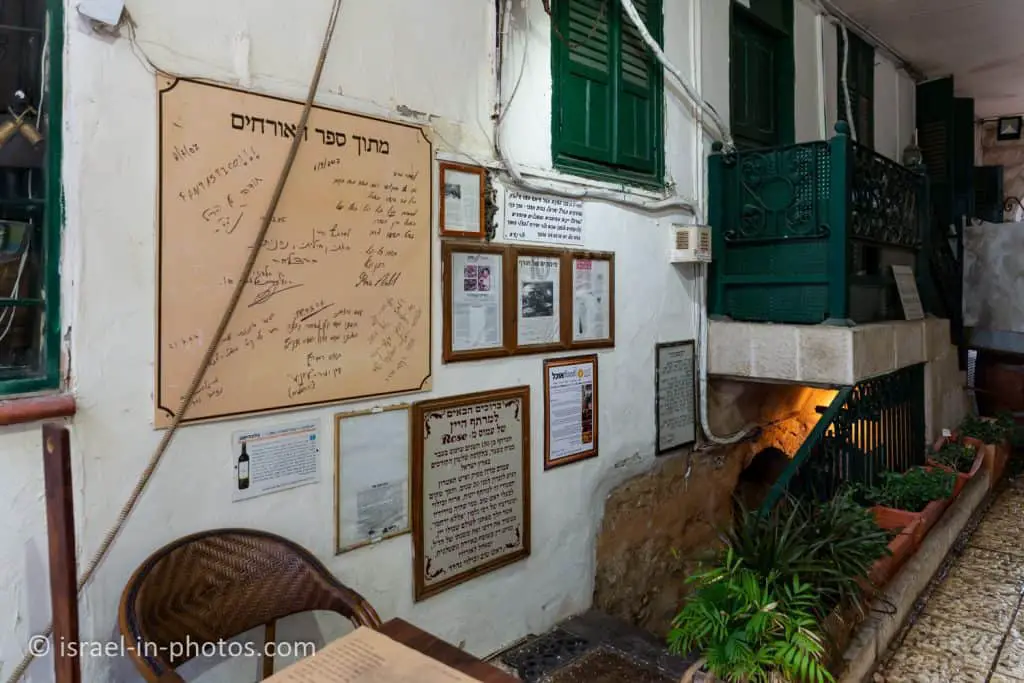
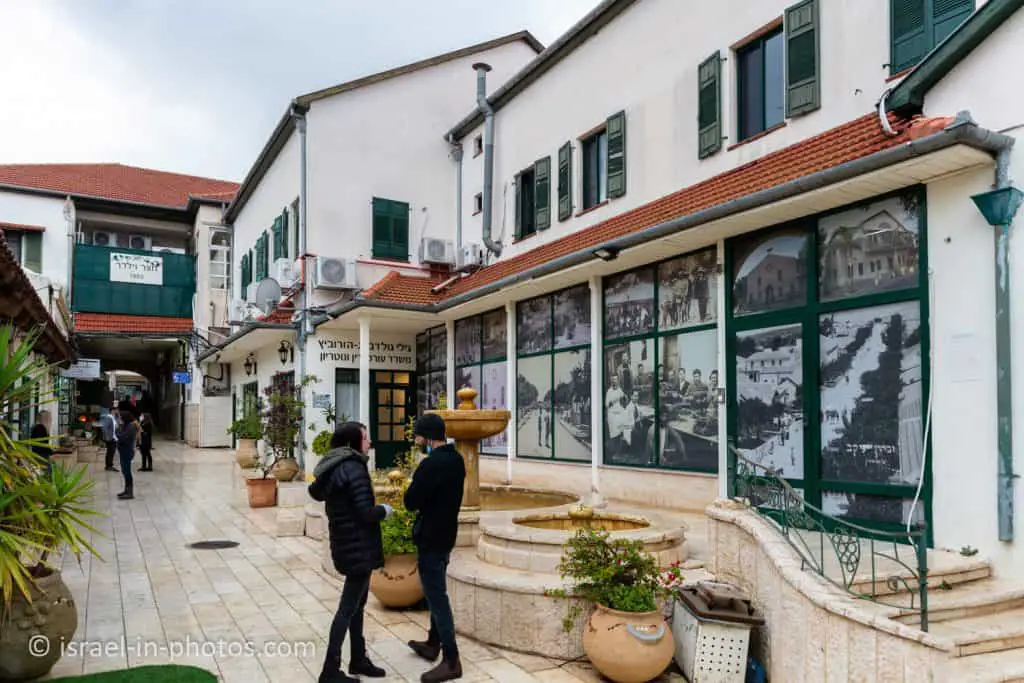
Restrooms
There is a free restroom on HaMeyasdim Street near Ohel Yaakov Synagogue. You can see the toilet sign on the left of the following photo.

Ohel Yaakov Synagogue
Ohel Yaakov Synagogue is one of Israel’s most beautiful synagogues. It was established in 1886, sponsored by Baron Edmond James de Rothschild, and was named Ohel Yaakov after the Baron’s father. The synagogue is located at the Moshava’s historic intersection (and not the highest point as was the custom in other Moshavot). It can seat 150 men, and about the same number at the women’s section.
A Rosetta window originally set above the entrance door was later replaced by a clock with Hebrew letters. A local artist created the Menorah at the top of the building. The synagogue’s interior design maintains the founders’ spirit, and in its center, you can see an original brass Hanukah menorah from the time of the Barron. Service is held in the synagogue every day. Visitors are welcome during the afternoon before the Mincha prayer. The place is open for prayer on Shabbat and Holidays.

We turned left to Ha-Nadiv Street. On Ha-Nadiv Street, you can find Tiyul Garden, the first ornamental garden in modern Israel, and the First Aliyah Museum.
The First Aliyah Museum
A must-see spot for all visitors who tour Zichron Yaakov, providing a peek into the reality of the first aliyah settlers’ courageous lives. Back in the days when they did not have coffee or water for making coffee, they raised families, battled diseases, planted vines, and prayed for yield. The Barron’s clerks run the show… And the rest is history.
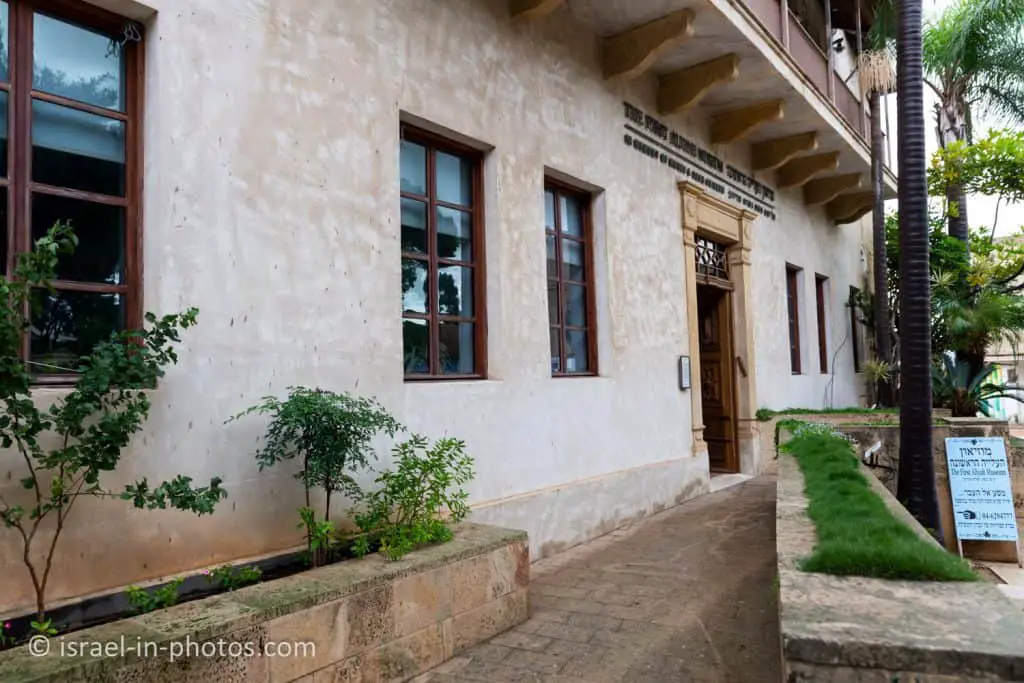
Then we turned left to Herzl Street and returned to the car.
The described path took us about two hours at a slow pace. Thus a typical visit would be 1.5 – 4 hours (depending on what museums you visit and where you eat). And if you want more, then see the next section.
History
In December 1882, one hundred members of the Hovevei Zion movement from Romania purchased land in Zichron Ya’akov (then known as Zammarin), intending to settle the land. However, the rocky terrain was challenging to farm, and an outbreak of malaria resulted in the deaths of adults and children. The main cemetery in Zichron Ya’akov is the last resting place of many settlers and their families. Their gravestones are still visible today. These difficult circumstances led many settlers to leave within the first 12 months.
In 1883, Baron Edmond James de Rothschild decided to assist the remaining settlers. Plans were formulated to develop the land for agricultural purposes and the establishment of a residential area. At this time, Baron Rothschild renamed the town Zichron Ya’akov in memory of his father, Baron James (Ya’akov) Mayer de Rothschild.Professional planners designed the main street with French-inspired, tiled-roof housing units facing the road. Behind each home lay a long interior courtyard and a rear building for storing agricultural implements. Today, this street is the main pedestrian street of Zichron Ya’akov and is known as the Midrahov, where cafes and specialty shops attract tourists and residents alike. The original courtyards and rear outbuildings are still visible in many places.
Elijah Shaid, the Baron’s clerk, was responsible for administration and ensured that each working farmer was paid a salary. He directed the agricultural economy according to the Baron’s wishes. The building which housed the administrative offices and where the Baron and his wife resided during their visits remains today as the National First Aliyah Museum opposite the public gardens known as the Gan Tiyyul.
The Baron also commissioned the construction of the Ohel Ya’akov synagogue in honor of his father. The synagogue has served Zichron Ya’akov since 1886 and is a notable feature of the town’s architecture at the northern end of the Midrahov. The synagogue holds daily services (with more on Shabbat and Holidays) and is much loved by the town’s residents.In 1885, following several economic failures, the Baron helped establish the first winery in Israel, the Carmel-Mizrahi winery. A bottling factory was also founded in the area – and can be visited as the Mizgaga Museum at Kibbutz Nahsholim. Initially, the winery was an economic success, but in 1892, the grapevines were attacked by phylloxera, and the harvest was destroyed. Subsequently, phylloxera-resistant American seedlings were planted, and the winery flourished once more and can now be visited as a working winery.
Zichron Ya’akov continued to develop slowly. In 1912, the population of the town was increased by new immigrants from Yemen, many of whose descendants still live in Zichron Ya’akov.
At the time of the First World War, the famous agronomist Aaron Aaronsohn and his family were living in the town. Turkish rule had resulted in great hardships for the residents. As a result, Aaron founded NILI, the undercover intelligence group that supplied information to the British government. His sister, Sarah, also became an agent for the British, and in 1917, she committed suicide rather than reveal any secrets to the Turks who had arrested her. The Aaronsohn House, now a Museum, is open to visitors.When the British came to power, the town began to flourish, and attempts were made to grow tobacco, olives, and flowers for perfume. By 1935 there were 1,650 inhabitants in Zichron Ya’akov. In 1951, three years after the founding of the State, the population amounted to 4,200 people. This number has increased over the years, and the population has grown to approximately 23,000.
Nowadays, Zichron Ya’akov is an important tourist attraction. The beautiful Rothschild Memorial Gardens, housing the tomb of the Baron and his wife at Ramat HaNadiv, is located within a nature reserve on the southern edge of town.
More recent development has witnessed the extension of the Wine Route (Derech HaYayin) through the Midrahov (pedestrian walkway) on Rehov HaMeyasdim (Founders’ Street), down towards the Carmel winery, and into the original core of the village of Zammarin.
Source: The Local Council of Zichron Yaakov
Nearby Attractions
There is a variety of attractions near Zichron Yaakov. And in this section, I will list several suggestions. Moreover, you can use the interactive map at the beginning of this post to find additional places.
- HaNadiv Gardens (Ramat HaNadiv) is a nature park with memorial gardens near Zichron Yaakov. And it offers three hiking loop trails and two cycling tracks.
- Taninim Stream Nature Reserve has nature, wildlife, and archeological remains. And its short trails make it perfect for a family visit.
- Caesarea National Park is among the most visited sites in Israel. Its significant archeological remains result from more than 2,000 years of history.
- At Ralli Museum in Caesarea, you can see the Dali collection, Latin American and Spanish paintings, sculptures, and more.
- Butterfly Nursery near Atlit offers fun and educational activity. You can learn about the butterfly life cycle, and you can also feed butterflies.
- Nahal Mearot Nature Reserve is a world heritage site. It is home to prehistoric caves where humans lived for 500,000 years.
- Dor Habonim Beach Nature Reserve offers picturesque sandy beaches and stunning bays not far from Zichron Yaakov.
Summary
You can taste wine, enjoy art, and learn history within a short walk in Zichron Yaakov. And if you love nature, there are plenty of attractions nearby.
Have you ever visited Zichron Yaakov? What are your favorite attractions in this city? Tell us in the comments below.
That’s all for today, and I’ll see you in future travels!
Stay tuned!
Additional Resources
Here are several resources that I created to help travelers:- Trip Planner with Attractions and Itineraries is the page that will help you create your perfect travel route.
- What is the Best Time to visit Israel? To answer this question, we will consider the weather, prices, holidays, festivals, and more.
- Information and Tips for Tourists to Israel will answer the most common questions tourists have about Israel (including safety, passports, weather, currency, tipping, electricity, and much more).
- Israel National Parks and Nature Reserves include a complete list, top ten, map, tickets (Israel Pass, Matmon, combo), and campsites.
- If you are looking for things to do, here are the pages for Jerusalem, Tel Aviv, Haifa, Sea Of Galilee, Akko (Acre), Eilat, Nazareth, Safed (Tzfat), and Makhtesh Ramon.



